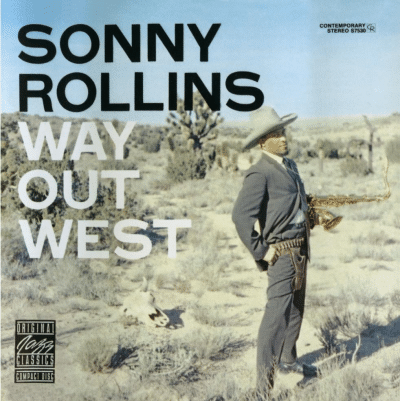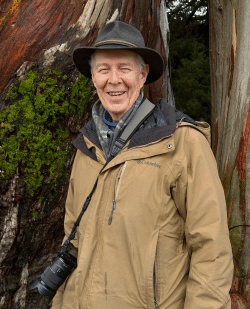.
.

Sonny Rollins’ 1957 album Way Out West (Contemporary Records) features the trio of himself on saxophone, bassist Ray Brown, and drummer Shelly Manne. Music from it is included in an extensive playlist Bob Hecht built around examples of prominent pianoless modern jazz.
.
.
___
.
.
…..The ‘tradition’ of pianoless modern jazz extends back more than seventy years, to the early fifties and Gerry Mulligan’s quartets with Chet Baker. Mulligan sought more harmonic freedom, eschewing the piano in favor of a more dominant role for the bass, and thereby enabling the soloists a greater feeling of openness or space for their own musical concepts.
…..Since those early experiments, the pianoless format (meaning here, more precisely, the absence of a chordal instrument, whether piano, guitar, or vibes) has been utilized extensively by an impressive array of notable, creative jazz musicians. These include a number of both ‘mainstream’ and ‘free’ jazz artists, such as: Sonny Rollins, Ornette Coleman, Lee Konitz, Dave Holland, Joe Henderson, John Coltrane, Steve Lacy, Avishai Cohen, Kirk Knuffke, Max Roach, Branford Marsalis, Joshua Redman, Jack DeJohnette, Warne Marsh, Kenny Garrett, Charles Mingus, Joe Lovano, Tom Harrell, Dave Liebman, Dave Douglas, Mark Turner, Elvin Jones, John Ellis, Ray Anderson, and others.
…..Mulligan once described his rationale behind his pioneering choice of cutting out the piano from so many of his bands:
…..“I consider the string bass to be the basis of the sound of the group, the foundation on which the soloist builds his line, the main thread around which the two horns weave their contrapuntal interplay … When a piano is used in a group it necessarily plays the dominant role; the horns and bass must tune to it as it cannot tune to them, making it the dominant tonality. The piano’s accepted function of constantly stating the chords of the progression, making the solo horn a slave to the whims of the piano player.”
…..Sonny Rollins explained the attraction for him of the pianoless format:
…..“I was kind of disappointed with piano accompaniment. I was obliged to play with it … but I couldn’t seem to find a guy who could contribute. They got in the way. They played too much. Their chords interrupted my train of thought. I ended up getting bugged at all piano players. And got this idea that I didn’t need piano. I feel it’s worked out much more successfully without a piano player.”
…..Ornette Coleman said this about the freedom attained without the chording instrument:
…..“… if you put a conventional chord under my note, you limit the number of choices I have for my next note; if you do not, my melody may move freely in a far greater choice of directions.”
…..It’s generally recognized that for the pianoless format to work musically, it requires not only a strong horn soloist (or soloists), but a bassist and drummer who can lock in together and stay rhythmically involved with the soloist. In capable, creative hands, the openness of the format allows for a great deal of interaction between the musicians, and a transparency that can enable the discerning listener to participate in those interactions. It can, in short, produce a liberating feeling in both the musicians and the listener.
…..Writer Peter Watrous described the phenomenon in a New York Times article in 1997, this way:
…..“…groups that perform pianoless often become more flexible; they open up. Without the pianist dictating the background, improvisers can look into the back alleyways of a tune without fear of playing clashing notes.”
…..In essence, it’s quite an adventurous choice for a band, akin to playing jazz ‘without a parachute,’ as another writer has described it. Such groups tend to sound less confined, even more expansive.
…..The following long-form Spotify playlist presents some of the most outstanding examples of the pianoless approach, and includes many of the artists mentioned in this introduction. Enjoy!
.
.
.
___
.
.

This playlist was assembled by Bob Hecht, who frequently contributes his essays, photographs, interviews, playlists and personal stories to Jerry Jazz Musician. He has a long history of producing and hosting jazz radio programs; his former podcast series, The Joys of Jazz, was the 2019 Silver Medal winner in the New York Festivals Radio Awards. In addition, he is a widely published fine art photographer, whose work has appeared multiple times in The Sun, LensWork, Black & White Magazine, Zyzzyva and other periodicals, as well as in the book, Dream of Venice in Black & White, published by Bella Figuera Publications. He lives with his wife in Portland, Oregon. His photo website is roberthecht.com.
.
.
In addition to putting together great playlists, Bob has conducted several fine interviews for Jerry Jazz Musician. Click here to read his interview with Pepper Adams biographer Gary Carner. Click here to read “Life in E Flat” – a conversation about Phil Woods – with pianist Bill Charlap and jazz journalist Ted Panken, and click here to read his interview with Alyn Shipton, author of The Gerry Mulligan 1950’s Quartets.
Click here to view all playlists published on Jerry Jazz Musician
.
.
___
.
.
Click here to read The Sunday Poem
Click here to read “A Collection of Jazz Poetry – Summer, 2023 Edition”
Click here to read “Ballad,” Lúcia Leão’s winning story in the 65th Jerry Jazz Musician Short Fiction Contest
Click here for information about how to submit your poetry or short fiction
Click here to subscribe to the (free) Jerry Jazz Musician quarterly newsletter
Click here to help support the ongoing publication of Jerry Jazz Musician, and to keep it ad and commercial-free (thank you!)
.
___
.
.
Jerry Jazz Musician…human produced (and AI-free) since 1999
.
.
.

































